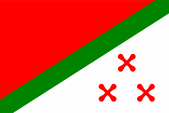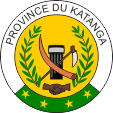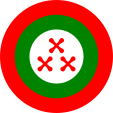Katanga |
|
|
|
| Übersicht – Contents: | |
Diese Seite ist Teil des Projektes
Katanga |
|
|
|
| Übersicht – Contents: | |
Flagge – Flag: |
|
 |
Nationalflagge – national flag, |
Bedeutung/Ursprung der Flagge – Meaning/Origin of the Flag: |
|
| Die Flagge sollte das Motto von Katanga repräsentieren: "Kraft, Hoffnung und Frieden in Wohlstand". Rot steht für die Kraft, Grün für die Hoffnung, weiß für den Frieden und die Croisettes stehen für Wohlstand. Sie sind eine Anspielung auf die traditionelle Währung der Region, das kupferne Katanga-Kreuz. | The flag has to
represent the motto of Katanga: "Power, Hope and Peace in Prosperity". Red stands for
power, green for hope, white for peace, and the Croisettes stand for prosperity.
They are an allusion to the region's traditional currency, the copper Katanga Cross. |
| Quelle/Source: Wikipedia (EN) | |
Wappen – Coat of Arms: |
|
 |
1961–1963, Wappen von Katanga – coat of arms of Katanga, Quelle/Source, nach/by: bemil.be |
 |
1997(?)–2015, Wappen von Katanga – coat of arms of Katanga, Quelle/Source, unbekannt/unknown |
Bedeutung/Ursprung des Wappens – Meaning/Origin of the Coat of Arms: |
|
| Das Wappen zeigte das gleiche Motiv wie die Flagge und sollte genau wie sie das Motto von Katanga repräsentieren: "Kraft, Hoffnung und Frieden in Wohlstand". Rot steht für die Kraft, Grün für die Hoffnung, weiß für den Frieden und die Croisettes stehen für Wohlstand. Sie sind eine Anspielung auf die traditionelle Währung der Region, das kupferne Katanga-Kreuz. | The
coat of arms showed the same motif as the flag and should exactly like it represent the
motto of Katanga: "Power, Hope and Peace in Prosperity". Red stands for
power, green for hope, white for peace, and the Croisettes stand for prosperity.
They are an allusion to the region's traditional currency, the copper Katanga Cross. |
| Quelle/Source: Wikipedia (EN) | |
Flugzeugkokarde – aircraft roundel: |
|
 |
1961–1963, Flugzeugkokarde – aircraft roundel Quelle/Source: nach/by Flags of the World |
Landkarte – Map: |
|
|
|
Zahlen und Fakten – Numbers and Facts: |
|
|
|
|
|
|
|
|
|
|
|
|
|
|
|
|
|
Geschichte: |
| 1891 ·
Katanga kommt zum Kongo-Freistaat 1960 · Unabhängigkeitserklärung durch Moise Kapenda Tschombé, den Chef der Regierung der Provinz Katanga 1962 · Intervention durch UNO-Truppen 1963 · Katanga kapituliert und wird wieder Provinz von Kongo-Kinshasa, Tschombé flieht nach Spanien 1964 · Tschombé wird Ministerpräsident von Kongo-Kinshasa 1965 · Tschombé dankt als Ministerpräsident ab und geht nach Spanien ins Exil 1967 · Tschombé wird von Spanien nach Algerien entführt und inhaftiert 29.06.1969 · Tod von Moise Kapenda Tschombé in der Haft 1971 · Umbenennung von Katanga in Shaba 1993 · Gouverneur Gabriel Kyungu Wa Kumwanza veranlasst offiziell die Rückbenennung der Provinz in Katanga, und erklärt diese für autonom 2015 · Katanga wird auf Beschluss des Präsidenten von Kongo-Kinshasa aufgelös und in vier einzelne Provinzen aufgeteilt (Haut-Katanga, Haut-Lomami, Lualaba, Tanganyika) |
History: |
| 1891 ·
Katanga comes to the Congo Freestate 1960 · declaration of independence by Moise Kapenda Tschombé, the head of the government of the Province of Katanga 1962 · intervention by UNO troops 1963 · Katanga surrenders and becomes a province of Kongo-Kinshasa again, Tschombé escapes to Spain 1964 · Tschombé becomes Premier of Kongo-Kinshasa 1965 · Tschombé resigns as Premier and goes to Spain in exile 1967 · Tschombé gets abducted from Spain to Algeria and imprisoned 29th of June 1969 · death of Moise Kapenda Tschombé in the imprisonment 1971 · rename of Katanga in Shaba 1993 · Governor Gabriel Kyungu Wa Kumwanza prompts officially the rename of the province in Katanga and declares it for autonomous 2015 · Katanga is dissolved by decision of the President of Congo-Kinshasa and divided into four individual Provinces (Haut-Katanga, Haut-Lomami, Lualaba, Tanganyika) |
| Quelle/Source: Atlas zur Geschichte, Wikipedia (D), Discovery '97 |
Ursprung des Landesnamens – Origin of the Country's Name: |
|
| Der Name "Katanga" für die Region und das Land ist schon sehr alt. Er wurde dem Land von arabischen Händlern gegeben. Der Name lässt keine Ableitungen aus dem heutigen Arabisch zu, so dass keine Bedeutung des Namens zu ermitteln ist. Es muss davon ausgegangen werden, dass es sich um einen Eigennamen handelt. Er ist in der Region aber identitätstiftend und tief verwurzelt, obwohl es einen regionalen Namen dafür gibt. Die Luba nannten das Land "Garanganja" oder auch "Garenganze", deren Reich sich hier erstreckte und das um 1890 im Kampf gegen die Chokwe unterging. Die Zentralregierung des Kongo hat seit dem Gewähren der Unabhängigkeit alles getan, um den Namen und den Gedanken "Katanga" auszumerzen. Zwischen 1971 und 1993 wurde die Provinz offiziell in "Shaba" umbenannt, und 2015 sogar aufgeteilt und zerstückelt. |
The name "Katanga" for the region and the country is already very old. It
was given to the country by Arab traders. The name does not allow
derivations from today's Arabic, so that no meaning of the name can be
investigated. It must be assumed that it is a proper name. However, it is
identity-creating and deeply rooted in the region, although there is a
regional name for it. The Luba called the landscape "Garanganja" or
"Garenganze", whose empire here existed and which was lost around 1890 in the
fight against the Chokwe. Since the granting of independence, the central
government of Congo has done everything possible to weed out the name and
the idea of "Katanga". Between 1971 and 1993, the province was officially
renamed in "Shaba", and in 2015 it was even split up and dismembered. |
| Quelle/Source: Volker Preuß | |